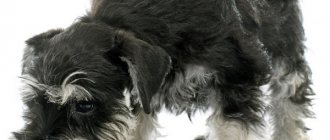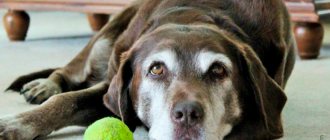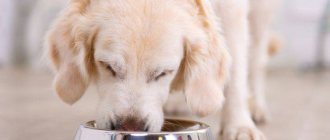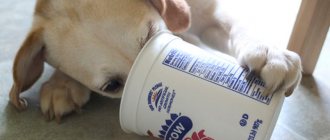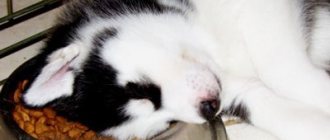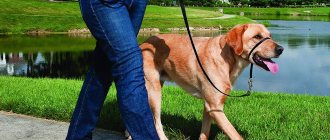A beautiful dog is a healthy dog. This law is inviolable and cannot be circumvented. The key to a pet’s physical health lies in heredity and quality of care. The future owner must clearly understand how to feed the Shih Tzu depending on its age and individual needs.
Important! Shih Tzus are not prone to food allergies to natural foods, but store-bought milk, processed meats and exotic fruits may well provoke a strong reaction from the body.
Nutrition rules
The following rules are provided:
- Food is given according to a schedule and only in a specially designated place.
- The food is not placed on the floor so that the habit of taking it from the ground does not form.
- After receiving the puppy, the diet is first provided with the same diet that was offered to him before.
- New items are added to the diet at the rate of up to one unit per day.
- Portion volume is carefully controlled. Everything that remains is superfluous and will not be offered again. On average, a serving is approximately 5% of the weight of an adult, up to 10% of the weight of a Shih Tzu puppy.
- It is monitored so that after eating the Shih Tzu's stomach does not bulge or become sunken.
If you do not break these rules, your Shih Tzu will be healthy and cheerful.
Meal frequency
If you feed your Shih Tzu natural food, then from birth to 2 months it is preferable to feed it 6 times a day. At 2-3 months, the portion size is made a little larger, but the number of meals is reduced - 4-5 times per day. At 4-5 months they feed up to 4 times a day, and at 6-11 months - no more than 3 times. A 12 month old pet is transferred to two feedings a day (morning and evening). Aging dogs (from 7-8 years old) are offered a reduced portion size and an increased number of repetitions of food intake up to 3-4 times.
- Dry food should be given after consultation with the veterinarian and in accordance with the instructions on the packaging material.
At least once a quarter, and also before mating, carry out preventive cleansing of the Shih Tzu's body from helminths. To do this, purchase medications against these parasites from a veterinary pharmacy.
Diet and feeding frequency
If you have adopted an older puppy, then you need to feed him only what the previous owner gave him, and new foods are introduced gradually. There is no definition of the exact portion for a puppy and an adult dog; you need to carefully watch how much the dog eats with appetite. What remains on the plate is unnecessary. Over time, an understanding of the normal portion will come to you (usually the portion is equal to 5% of the weight of an adult dog and up to 10% of the total weight for a puppy). After eating, the dog’s stomach should not be sunken, but it should not stick out like a football either.
It is necessary to adhere to a certain number of feedings:
- up to 2 months of age, puppies are fed 6 times a day;
- in the period from two to three months, the shaggy baby should receive 4-5 servings, the volume of which increases slightly;
- at 4-5 months the animal is fed up to 4 times;
- from six months to 11 months - no more than 3 times a day;
- from the age of one the Shih Tzu is transferred to two meals a day;
- in old age (after 7-8 years), portions are reduced and divided into 3-4 feedings.
When feeding dry food, portions are determined by the veterinarian and the instructions on the package.
Benefits of dry food
When purchasing a pack of dry food, you need to know that it can be completely different, both in taste and composition. There is dry food for Shih Tzu dogs that is softer and more gentle, then on the packaging they write that it is for puppies or pregnant bitches.
Dry and balanced food is available for different breeds, as well as with dietary supplements for allergies and other diseases. If you have decided, then you no longer need to buy additional vitamins for your Shih Tzu, everything you need is in the package and the manufacturers have tried to ensure that all components in the food are balanced.
When giving dry food, you need to accurately calculate the amount, especially for a puppy. After all, at this age the foundations of a healthy diet are just being laid, but all dogs eat differently. Make sure your puppy is fed but not overeated. To do this, check the norm according to the state of the bowl after the next feeding so that there is no excess left, and if the portion is not enough, add a little more.
The fact is that each individual dog has its own appetite and what is indicated on the package by age and weight does not always exactly match. Don’t forget to ask if the food is fresh and check its expiration date.
The advantages of food are that you don’t have to stand at the stove for a long time and perform manipulations to feed the puppy; you just need to pour the amount into a bowl and that’s it. The rest of your free time can be devoted to the Shih Tzu and caring for her, affection and coat care. Such nutrition also frees you from constantly heating food, and your head from fantasies about preparing such a dish to please your pet.
If you keep your Shih Tzu on a natural diet, it takes time to “jump” from it and switch to dry feeding. To do this, gradually introduce dry food into the diet, mixing it with regular dishes. By gradually eliminating the amount of food (natural), you will be introduced to other foods in about a week or two. Do not try to suddenly switch to another feeding. This threatens to cause problems with the digestive system of the delicate dog.
Watch your drinking - the bowl of water should always be filled to the top. Change the water so it doesn't stagnate and make sure your dog drinks plenty of water. If this does not happen, you need to consult a veterinarian.
Dry and natural food
Many owners cannot decide what is better to feed their pet - dry or natural food. Some argue that homemade food is healthier. However, experts assure that dry food is in no way inferior to natural food. In addition, ready-made food significantly saves time, contains the necessary complex of vitamins and minerals, has a long shelf life, and is convenient to take with you on a trip.
Similar article: History of origin and description of the Shih Tzu breed
Perhaps the only significant drawback is the high cost. Please note that feeding cheap food will not provide your Shih Tzu with the nutrients it needs. Only super premium food can fully satisfy all the dog’s needs. A Shih Tzu should include both dry and wet food in its diet.
If you decide to give preference to natural women, this is also correct. True, you will have to take care of vitamin supplements. In this case, it is better to seek help from a veterinarian. Meat products must be present in the diet:
- beef;
- veal;
- chicken;
- rabbit;
- beef liver;
- tongue, stomach.
For a puppy
At 2-3 months of age, the owner of a Shih Tzu puppy decides how to feed the pet further. When feeding changes from what was previously offered, a gradual transition to the new option is required. Over the course of 7-10 days, smooth changes are made - the food is partially replaced with a new one. At the same time, the reaction of the Shih Tzu's body to such changes is monitored. If problems arise, they abandon the new product.
The natural menu includes:
- fermented milk products (for example, kefir, yogurt), if the baby’s body accepts them well
- milk porridges (for example, rolled oats)
- lightly cooked meat (for example, beef, chicken, rabbit)
- vegetable purees with oil or fish oil (contains vitamins, promotes development)
- cooked sea fish (2-3 times a week)
- boiled eggs (up to 2 pieces per week).
If you plan to give ready-made food, then super-premium is preferable.
A significant amount of micronutrients are also provided for the growing Shih Tzu through multivitamin supplements selected on the advice of a veterinarian.
At 3-7 months, when the Shih Tzu puppy changes teeth, calcium gluconate tablets (or an analogue) will be required every day until the process is completed. During this time, very solid foods are avoided in order to maintain the correct taste.
What to feed a Shih Tzu puppy
When the puppy is 2-3 months old, the owner is faced with the question of choosing a diet: natural or dry. If your choice differs from what the dog was used to eating before (for example, while it was with the breeder), then you need to switch it to a new diet within a week, each time replacing part of the food with a new one.
A four-legged baby's menu must include:
- cottage cheese, kefir, yogurt - if the dog reacts normally to liquid fermented milk products;
- porridge cooked with milk (rolled oats are considered the healthiest, but you can use rice or buckwheat);
- slightly boiled meat - give preference to beef or chicken, you can use rabbit;
- prepare vegetable purees for your pet with vegetable oil or fish oil - the best vitamin supplement for fast and proper development;
- 2-3 times within 7 days you can give your Shih Tzu boiled sea fish;
- boiled eggs should also be present in the diet in an amount of up to 2 pcs. in Week.
During this life cycle, the dog requires large amounts of calcium and phosphorus. You can get them from a multivitamin supplement recommended by your veterinarian. If you choose a dry diet, give preference to the super premium class marked “Junior” or “puppy”. At 3-7 months of age, when the Shih Tzu's teeth change, give the puppy 3 tablets of calcium lactate or gluconate per day.
Industrial feed
Starting from the age of one month, a Shih Tzu puppy must be accustomed to “adult” food. At this age, industrial food begins to be introduced. The Shih Tzu puppy should be fed dairy food for a month. Pet stores have special mixtures with dog milk. From two months onwards, you can offer your dog several small pieces of high-quality commercial food. It must be soaked in water or milk.
Further feeding with industrial products should be carried out according to the diagrams on the packages. Factory food should be premium or super premium. All industrial products are divided into dry food and canned food. Experts recommend alternating these two ready-made foods. Feeding your pet only dry food can lead to problems with tooth enamel. And a large number of industrial canned food affects the formation of tartar.
The transition from natural products to ready-made food is carried out gradually. The reasons for the transfer may be allergies, dull coat, individual intolerance or weight fluctuations. During the week, a small amount of dry and canned food is added to the Shih Tzu's diet. It is recommended to gradually increase the portion and change brands. This may help identify adverse reactions to specific foods.
The formula by which the translation is carried out: daily food intake / 7 days. On the first day, they give 1/7 new food and 6/7 old food. On the second day 2/7 and 5/7. And so on until homemade food is completely replaced with ready-made food.
It is worth choosing professional products of the highest class. The most famous and specialized line is Royal Canin for Shih Tzu. Breeders also prefer the brands Innova, Eagle Pack, Pro Pac, Pro Plan, Bosch, Eukanuba, Hill's. This ready-made food will provide your pet with excellent condition and a healthy appearance. The lines of these brands include food designed specifically for small breed dogs.
The energy value of the food and its variety should correspond as closely as possible to the age, constitution, weight and condition of the Shih Tzu. The feeding schedule and the amount of factory feed are always indicated on the packages.
For an adult dog
If you plan to feed your Shih Tzu natural food, then the following dishes are provided:
- from meat (raw and boiled) – 0.25 kg per day;
- from boiled offal - twice a week;
- in the form of fermented milk products - three times a week or more often;
- from eggs (boiled, fried);
- in the form of porridge (with vegetable or butter, without oil), cooked in whey or milk - from 25% of the daily requirement;
- with herbs and chopped vegetables;
- with a small amount of dried fruits and berries.
To prevent the appearance of roundworms, once every 7 days you are given a piece of bread with butter and a sprinkle of squeezed garlic. It is allowed to salt the food, but occasionally, not daily. Select dry food that has a large amount of Omega acids, vitamins A and E.
- There are varieties for puppies, adolescents, adult Shih Tzus, as well as for dogs expecting offspring and wet nurses. Information about the intended use is on the packaging.
Super premium dry food for Shih Tzu is preferred. It is allowed to soak it if the pet does not always agree to eat it in its original form. Canned food for dogs is useful when feeding.
It is possible to use a mixed type of feeding, when in addition to natural food, the diet includes dry food. This approach is optimal if you need to go somewhere and take your Shih Tzu with you, because... on the road it is more convenient to use ready-made food.
If you choose to feed natural food or canned meat, then after eating the decorative hair on the Shih Tzu’s face is washed in warm water, then dried or wiped.
Feeding an adult dog
At the age of 1 year, the dog is considered an adult and is fed 2 times a day. If you prefer dry food, then choose professional brands. You can also give canned dog food. When feeding natural foods, stick to the list of allowed foods and never feed prohibited ones. Sometimes claims about mixed feeding are misunderstood. This does not mean that a Shih Tzu can be fed natural and commercial food - these are just recommendations to mix dry and wet food.
An adult dog should be fed porridge consisting of vegetables, grains and meat (15% of meat products can be replaced with offal).
Shih Tzus need vitamins and an additional source of protein, such as nuts. It should be taken into account that they should be introduced into the diet gradually, and walnuts are generally contraindicated. Shitzik can be given chicken or quail eggs twice a week. Almost all vegetables and fruits (except citrus fruits) and dried fruits are allowed. Fruit salads are seasoned with olive, linseed, and corn oil. Dishes made from fermented milk products are given 3 times a week.
Making up a diet
Natural food for Shih Tzu, the menu and its detailed consideration are presented in the table. The diet is designed for adult representatives of this breed.
| Day of the week | Morning | Evening |
| Monday | Rice cereal - 100 grams, boiled beef meat - 250 grams | Vegetable stew: potatoes, carrots, zucchini, seasoned with 0.5 teaspoon of vegetable oil - 250 grams |
| Tuesday | A pack of cottage cheese up to 5% fat (200 grams), whipped with kefir | Buckwheat - 50 grams, boiled carrots - 20 grams, turkey meat or veal - 250 grams. |
| Wednesday | Boiled by-products (liver, heart, kidneys) - 250 grams | Rice cereal - 50 grams, zucchini - 50 grams, potatoes - 100 grams in the form of stew |
| Thursday | Buckwheat porridge - 100 grams, kefir - 200 grams | A pack of cottage cheese - 200 grams, kefir - 100 grams |
| Friday | Boiled fish - 200 grams | Rice cereal - 200 grams, boiled fish - 50 grams |
| Saturday | Vegetable stew with veal or rabbit - 250 grams | Buckwheat - 250 grams, vegetable oil - 0.5 teaspoon (add to the finished porridge) |
| Sunday | Chicken, turkey and veal meat - 250 grams | Rice cereal - 50 grams, zucchini - 50 grams, potatoes - 50 grams in the form of a stew, seasoned with egg (2 pcs.) |
And a few more tips regarding the menu that will be useful to the owner of a chrysanthemum dog:
- Meat is given only boiled or scalded with boiling water. To avoid problems with the gastrointestinal tract, it is better to boil it.
- Be careful with chicken meat. May cause severe allergies in your pet.
- Low-fat fish is boiled, the bones are carefully selected and only then given to the dog.
- Vegetables are cooked until tender. They should be soft. You can offer your Shih Tzu zucchini, potatoes, carrots, squash, and bell peppers.
- Eggs are given only raw. Chicken - 2 pieces per week, quail - 4 pieces per week.
- You cannot offer your pet pork, seafood, citrus fruits, sausages, cheeses, sweets and chocolate. In general, all junk food for humans. Pork and seafood are not included in this list, but pork meat is very fatty for dogs. Seafood has too much protein.
- The dog should always have water available.
What to feed your dog?
WHAT NOT TO FEED
- hot (straight from the stove), cold (from the refrigerator), spicy, salty, fatty, sweet, smoked food; - river fish. You can only give boiled seafood. Never give freshwater or raw sea food, as infection with worms is possible; - You can’t give bones instead of food. Contrary to popular belief, bones are death for a dog. Firstly, they are not digestible. Secondly, they can cause constipation, intestinal perforation, and volvulus. Tubular bones are especially dangerous, as they tend to split into sharp pieces. Bones also contribute to rapid grinding of teeth; - you cannot constantly feed pasta, legumes, white bread, potatoes, peas, and wheat flour products; - the dog should not know what sausages, sausage, or ham are. However, it seems that soon even people will not know about these products. But we know many owners who are capable of doing the incredible for their pet and will not stand up to any expenses or difficulties. In this case, all this is completely in vain. Sausages are poison for dogs. They damage the liver, and the dog runs the risk of dying at a young age. After all, we don’t know what additives are added to sausages to make them look attractive; — the puppy should not know the taste of sugar and sweets. Sweets spoil the appetite and disrupt digestion. In addition, they destroy teeth and have an extremely adverse effect on the eyes, which begin to water; - do not feed pork and fatty lamb, raw chicken; — you cannot add spices to your dog’s food: pepper, bay leaf, hot tomato sauce; - feed rotten and sour foods.
FOOD FOR OUR PET
A dog is a carnivorous creature, so the basis of the food should be protein products: meat, mainly raw, dairy products, eggs. You can't raise a good puppy on cereals and soups. They contribute to the looseness of the constitution. Meat. It is recommended to feed only beef, and mainly raw. Many dogs are irritated by the smell of blood and refuse raw meat. In this case, it must be scalded with boiling water or lightly fried. Up to a year, a puppy should be given 50 g per day per kilogram of weight. An adult dog can be given 200-250 g of meat per day. The liver, kidneys, heart, and udder contain a lot of useful substances, but they must be given well boiled. Finely chopped vegetables should always be added to meat feeding. Never give bones. But there is an exception to this rule. It refers only to soft cartilage, and even then in small quantities. You can give a boiled chicken neck, previously broken with a hammer. Dairy products. In first place, of course, is cottage cheese, as the main source of well-absorbed calcium. A puppy up to one year old should be given calcined cottage cheese, which you have to prepare yourself. To do this, add 2 tablespoons of 10 percent calcium chloride to half a liter of boiling milk. Throw the curdled cottage cheese onto a sieve. When the whey has drained, cool slightly and give to the puppy. The remaining whey can be left for drinking or brewed with Hercules oatmeal flakes, which can be given for another feeding. Milk is food, not drink. It is very useful, but it makes some dogs weak. Kefir and yogurt have a good effect on digestion and are very useful. It is useful to add grated cheese to porridges and vegetable mixtures. It is also convenient to use as a treat during training. Eggs. The product is very nutritious. Raw yolks are best given mixed with dairy products or porridge. Crude protein is undesirable, in addition, it is simply not digestible. Eggs can be fed soft-boiled or as an omelet. With systematic meat feeding, one or two eggs per week is enough. Cereals and bread. These products cannot be the cocker's main food, but their use in small quantities is quite acceptable and even necessary. The nutritional value of cereals is variable. In first place is “Hercules”. It should be soaked in kefir, whey, broth, and milk. It is better not to cook it, but to give an adult dog raw flakes. It is acceptable to cook porridge from rice, buckwheat, and millet for a puppy. Pearl barley irritates the puppy's intestines, so it should be given in small quantities, or better yet excluded from the diet altogether. When cooking porridge with milk, it is good to add cabbage, carrots, pumpkin and other vegetables, except potatoes. An adult dog and a teenage puppy should definitely be offered to chew rye bread crackers. Vegetables. It is useful to give carrots, cabbage, pumpkin, rutabaga, zucchini, beets and other vegetables finely chopped or grated, adding butter or sour cream in small quantities. Raw chopped greens - parsley, lettuce, onions and garlic, dill - are an excellent vitamin supplement to the main food. Puppies can be given a vegetable mixture as an independent dish. Raw berries and fruits, dried fruits are good for him. Boiled pumpkin with porridge is good as a vitamin food and anthelmintic. When organizing feeding the puppy, keep in mind that the puppy must be introduced to dairy products, especially cottage cheese, vegetables and fruits from an early age. Garlic. Raw finely chopped garlic (1 clove) on a piece of bread with butter is useful to give to a puppy and an adult dog weekly as an anthelmintic. Raisins, dried fruits, cheese. All this is a convenient and useful bait, which is used as a reward during training. Salt. A dog requires significantly less salt than a person. Therefore, it is not necessary to add salt to food; it is enough to give a piece of herring once a week. Chalk, coal. Apparently, the puppy needs them during the period of increased growth and bone development. The pieces should be in a place accessible to the dog. She will chew them as needed. During the period of teeth change (from 3 to 7 months), it is recommended to give the puppy 2-3 tablets of calcium gluconate or lactate per day. If the puppy does not eat calcium tablets, then they should be ground in a coffee grinder and added to the food.
Information from the website of the ZOOVET Veterinary Center
BACK TO THE LIBRARY SECTION
For an aging pet
After the Shih Tzu reaches 7-8 years of age, further feeding is replaced with low-fat food to avoid obesity. Associated with a decrease in physical activity and a decrease in calorie needs.
If there are no problems with dry food, then natural feeding is chosen without fatty foods and anything that leads to problems in the functioning of the gastrointestinal tract. A single meal becomes smaller in volume, and the amount of protein food is slightly increased.
To correctly create a diet, contact a veterinarian and select vitamin supplements and diet.
What to feed an aging dog
When the dog reaches 7-8 years of age, it should be switched to a low-fat diet. Low calorie content is an important requirement for both natural and dry feeding. At this age, the animal stops actively moving, so it does not need as many calories (which in excess can cause obesity).
Dry food for an older dog is not difficult to find. And in natural nutrition, you need to make some changes, getting rid of what can cause problems in the gastrointestinal tract, as well as fatty foods. Portions are slightly reduced, but the amount of protein food is slightly increased. To create the best diet, you need to consult a veterinarian, he will help you choose the right vitamin supplements and prescribe a high-quality diet.
Reviews
Anatoly, Lipetsk
“Nowhere does it say that this breed also suffers from coprography. They eat their own and other people's feces. They say that in order to wean them from this bad habit, they need vitamins. We gave it to ours as a preventive measure, although we haven’t noticed this in her since childhood. Perhaps this is due to the fact that she is completely on dry food and feces after this type of feeding do not attract her. )) I had indigestion a couple of times - we decided to introduce a different brand of food. But we realized that it was better to stay with Royal Canina.”
Elena, Zelenograd
"Hello. Our baby only eats rice from cereals. That is, we usually give her rice + beef or rice + chicken legs. I also add carrots or chopped green apple. We don’t like cottage cheese, but once a week I mix a teaspoon into the milk.”
What to feed an adult Shih Tzu
Natural food for Shih Tzu
A natural diet should consist of:
- Meat. Beef, horse meat, and rabbit will be the best choice. You can feed your dog unprocessed meat products, but if you are not sure that it is free from germs and parasites, then it is better to boil the product. 250 g of meat per day is enough.
- Offal. A couple of times a week you can feed your Shih Tzu chicken and beef offal, including necks. Everything needs to be boiled well.
- Dairy products. indispensable in the diet, they should be given at least 3 times a week. It is best to choose low-fat cottage cheese, kefir, and yogurt.
- Eggs. They absolutely need to be included in the diet; they need to be boiled or fried.
- Cereals. should make up at least a quarter of the daily diet. It is best to choose rolled oats, buckwheat, millet or rice. Porridge is cooked with fresh milk or whey. You can also add vegetables to them. Add a little vegetable oil to the porridge.
- Vegetables, fruits and greens. It is recommended to add chopped vegetables to meat dishes and rich porridges. Beets, pumpkin, and zucchini are added to the diet. Both boiled and fresh vegetables should be present. Any greens will be an excellent vitamin supplement. Berries and dried fruits can also be given to an adult dog in limited quantities.
If you give your Shih Tzu a slice of bread spread with butter and sprinkled with squeezed garlic once a week, he will not have worms.
Sometimes you can add salt to your food, but you shouldn't do it every day.
Water and fertilizing
The volume of clean, fresh water consumed should not be limited. It is made available to the dog regardless of the time of day. Make sure it doesn't end. Clean the bowl (automatic drinker) daily and change the liquid in it.
- Seaweed, bone and meat-and-bone meal, ground eggshells, and salmon fish oil are used as fertilizers. Vitamins in tablet form are beneficial - they are eaten like treats. Vitamins and minerals are added to thermally processed dishes, and oil is added to fresh vegetables and meat.
Ingredients:
Rice, dehydrated animal proteins (poultry), animal fats, vegetable protein isolate, hydrolyzed animal proteins, vegetable fibre, beet pulp, minerals, fish oil, soybean oil, fructooligosaccharides, borage oil (0.1%), extract marigold erecta (source of lutein), green tea and grape extracts (sources of polyphenols), crustacean shell hydrolysate (source of glucosamine), cartilage hydrolysate (source of chondroitin).
If the disease does occur
It happens that an allergic reaction manifests itself over time. The pet has already been living in the house for a couple of months, and family members have just started showing allergy symptoms.
In this case, there are two options for solving the problem: look for a new home for the pet or use medications to eliminate allergic manifestations. And if in the first option everything is clear, then in the second case there may be difficulties.
An allergy to a dog can be either mild or severe. If the reaction to animals is pronounced, continued presence in the same room with a dog can be dangerous for humans and lead to the development of chronic diseases.
How to treat an allergy to a Shih Tzu if you still develop it? Doctors prescribe allergy sufferers to take a course of medications, which include Claritin, Benadryl, Cirtek and others. The course must be repeated every couple of months. Without the use of medications, allergy sufferers will not be able to live normally in the same house with a dog.
Interesting! Animals can also be allergic to their owner. Approximately 5% of pet dogs developed a rash caused by a reaction to human contact.
Traditional medicine offers other treatments for allergies, including to Shih Tzu.
- Freshly squeezed celery root juice. You need to take it a few teaspoons half an hour before meals, before each meal. This will help minimize the manifestation of allergies.
- A mixture of juices will also work. You need to mix the juice of carrots, apples, parsley and cauliflower inflorescences in equal proportions. It should be drunk three times a day 25 minutes before meals.
- Dill compress for itching. Dill juice should be mixed with water in equal proportions and applied to the area where redness occurs for 10 minutes. After a couple of hours, the compress can be repeated.
- Shilajit treatment course. One gram of mumiyo is dissolved in a liter of boiled water at room temperature and drunk in the morning. Children under 7 years old should be given 50 ml per day. The course of treatment must last at least 20 days.
If you are going to visit friends who have a pet, the allergy sufferer needs to start preparing for the meeting with their four-legged friend a week in advance. In this case, you need to take antihistamines. They will negate the possibility of allergies.
How many times should you feed your Shih Tzu?
Please note that your dog’s diet depends primarily on his lifestyle. A pet that walks a lot and is constantly active should consume more calories than a “laptop” dog that often spends time at home due to lack of attention from its owners.
The well-being and appearance of your still so small Shih Tzu in the future will depend on proper feeding from childhood.
- At 1.5 months he should eat 6 times a day;
- A 2 month old baby needs to eat 5 times a day;
- From 3 to 6 months of a Shih Tzu's life, it is enough to eat 4 times;
- From six months the puppy eats 3 times a day;
- From one year of age, the pet begins to eat twice a day (morning and evening).
List of prohibited foods
You should not feed your Shih Tzu meat with high fat content, smoked meats, river fish, raw liver and bones (which can cause damage to the digestive tract), and sweets (which cause problems with teeth and excess weight).
Do not feed the Shih Tzu legumes - due to increased gas formation, bloating appears in the stomach; do not give milk to drink - due to the risk of digestive problems.
There is no place in feeding for salty and spicy foods, processed foods, potatoes, white flour products, spices, pearl barley, soybeans, pasta and corn grits. Do not give very hot or very cold, rotten or sour food.
- If an upset stomach occurs, the Shih Tzu is given rice water or herbal infusions (chamomile, St. John's wort), which normalizes stool.
An alternative is to take bifitrilak for 1-2 days. It is also recommended for recovery after poisoning. The main thing is not to let the problem get worse and start treatment on time.
Conclusion
The owner of a Shih Tzu does not have any difficulties in choosing a feeding method. The best choice is to feed with natural food. If this is not possible, then super-premium granulated food is suitable.
What should you not feed your Shih Tzu?
Never feed your little pet the following foods:
- Never feed your pet river fish - its diet should contain exclusively sea fish;
- Cold or too hot food;
- Semi-finished products. Foods such as sausages can literally kill a dog;
- Dogs should not eat bones because they cause constipation;
- Sweets, spicy, salty, and fried foods;
- You cannot feed your pet spoiled food (even after heat treatment);
- To prevent your dog from having a craving for sweets, try not to treat him to them from early childhood;
- Beans, potatoes, pasta, white flour products are prohibited.
Grooming
The difficulty of keeping a Shih Tzu lies in the need for careful care of its long hair. The appearance of an exhibition animal requires special attention.
Victoria:
Contrary to popular belief that Shih Tzus do not shed, I have to disappoint everyone who is planning to get this dog: they also shed! Our Justin, if he is not brushed daily, is capable of cleaning all the furniture and floors. Only a slicker can save you.
If a Shih Tzu participates in exhibitions, caring for a long coat is quite troublesome. You need to buy a lot of all kinds of dog cosmetics for grooming, tie a ponytail on your head - a topknot, curl curlers.
We don't go to exhibitions, so we keep Justin's hair short. Sometimes in extreme heat we may shave our heads. But the hair on the face still gets dirty when eating. Therefore, after each feeding we wash our handsome little one.
Nikolay:
I would like to warn everyone who has decided to get a Shih Tzu: combing, cutting, and knitting ponytails will take a lot of time. But for those who love their dog, it will be a pleasure. How nice it is to then walk around the city with a well-groomed pet that everyone pays attention to!
Yana:
Unfortunately, I don’t have enough time for grooming - this can be seen even in the photo, although she is a puppy. In general, I cut Bonya's hair. In my opinion, she feels quite comfortable with this. And there is no dog smell from the Shih Tzu, even if they get wet in the rain. I have been convinced of this more than once.
Hope:
I brush my pet every day. Two or three times a year we go to the groomer and get a haircut. When walking in wet weather, we wear overalls so that the wool doesn’t get so dirty. Of course, when she sheds, you need to brush longer and preferably more often. I bathe her every two weeks and there is no smell.
Lyalina hygienic haircut for the summer (photo taken in the spring of 2015).
Content Features
The Shih Tzu's eyes, due to their large size and protuberance, require special care and attention. It is also necessary to pluck hair from the ears to improve their ventilation and avoid otitis media.
Hope:
Sometimes her eyes water. It happens because she is allergic to certain foods. Shih Tzu eyes are generally prone to inflammation. Long hairs that get into the eyes can also cause them to fester. Sometimes conjunctivitis occurs in the summer if dust gets into the eyes. That's why I keep them clean. I wash it with a special lotion and trim the hair around the eyes.
Yana:
You have to take very careful care of your eyes. This is a feature of the breed. Our friend's dog, also a Shih Tzu, has eyes that fall out when he is very frightened. Bonnie has never had anything like this. I don't know what I would do in this case. But we take care of the eyes: we wash them, clean the corners, and trim around them.
Victoria:
Shih Tzu ears are something... When our dog was still a puppy, we forgot that we needed to pluck the hair out of them, and gave the poor thing otitis media. His ears turned red inside, and he constantly shook his head. Now we are carefully monitoring the condition of our ears so that this does not happen again.
Prohibited Products
Dogs' bodies are different from humans', and what is good for humans cannot always be given to dogs. The owner of this amazing dog should definitely get acquainted with the list of foods that are strictly prohibited for feeding:
- Bones – representatives of this breed do not have a very strong dental system, so gnawing bones will be an unnecessarily strong load for it. In addition, bones from fish or chicken can damage the organs of the digestive tract - scratching or piercing the walls.
- Raw fish is often a source of parasites, and therefore requires mandatory heat treatment, but feeding your dog river fish in any form is not recommended, since it is excessively bony.
- Milk is an ideal food for puppies, but the body of an adult animal practically does not digest lactose, so it is advisable to replace this drink with fermented milk products.
- Sausages, smoked meats - even their benefits for humans can be doubted, but they are definitely harmful to dogs, as they contain artificial additives that harm the dog’s liver and disrupt the digestive processes.
- Confectionery products – chocolates, sweets and other foods containing sugar have a negative impact on your pet’s vision, weight and metabolic processes. No matter how much your pet begs for sweets, you cannot give him such foods.
- Salt – the use of this seasoning provokes an imbalance of water and electrolytes in the animal’s body, which can cause seizures and even heart failure.
- Coffee – pets’ bodies are more sensitive to caffeine, so it can cause arrhythmia, hypertension, seizures, and vomiting.
- Alcohol - consumption of even a small amount causes poisoning with all the accompanying manifestations of serious intoxication.
- Macadamia nut – contains substances that are strong toxins for the body of animals. After eating a piece, the dog will experience symptoms of intoxication after a while.
- Grapes – contain substances that negatively affect the functioning of the dog’s kidneys. This berry can cause fermentation in the intestines.
It is advisable for the owner to protect the dog from eating junk food, which will save the pet from negative consequences.
Walks or diaper?
The Shih Tzu needs daily walking. This pet will not wear a diaper instead of full walks. Reusable diapers can be used as a temporary solution for up to 3-4 months. Read about toilet training here.
Victoria:
While Justin was very tiny, of course, we put a diaper on him. He hit her with varying degrees of success. When he grew up, from the age of five or six months the question of diapers disappeared. On the street he has a lot of important things to do - sniff everything, mark every corner, say hello to everyone he knows.
Yana:
I tried to accustom Bonya to a diaper, but I failed. The breeder taught her to go outside, and I was unable to change her habit. Therefore, if you left her alone for a long time, you could then find a puddle in the hallway. I solved the problem with reusable diapers. And if you take her outside on time, she will never allow herself to do this.
During their walk, Bonya and her little son get into such crazy running around that I can’t imagine how I could force her to sit locked up all day. They would destroy my whole house.
Did you like the article? Give it a like!
Larisa, Bogdanovich
March 27
Hello. I have a Shih Tzu, one year and 4 months old. An allergy has appeared, it is impossible to determine what exactly. Manifests itself in the form of redness of the chest, tummy and the inside of the paws. The dog's diet included: chicken, beef, rice, buckwheat, carrots, tomatoes, bell peppers, pumpkin, zucchini. First I eliminated tomatoes and peppers, then chicken and buckwheat, now I replaced pumpkin and beef with turkey. I have been trying to detect the allergen for about two months now, to no avail. After taking kefir, the tummy becomes light, but after porridge it turns red again. Give me advice on what I should do. The city is small, they won’t do a blood test for allergens. Doesn't eat dry food.
On the Ask a Doctor service, you can consult a veterinarian on any problem that concerns you. Expert doctors provide consultations around the clock and free of charge. Ask your question and get an answer immediately!
Similar questions
Breed
August 4
Esther, Odessa
What should I do if I haven't found the answer to my question?
If you have a similar or similar question, but you haven’t found the answer, get your free online consultation with a doctor.
If you want to get a more detailed consultation with a doctor and solve the problem quickly and individually, ask a paid question in a private personal message. Be healthy!
